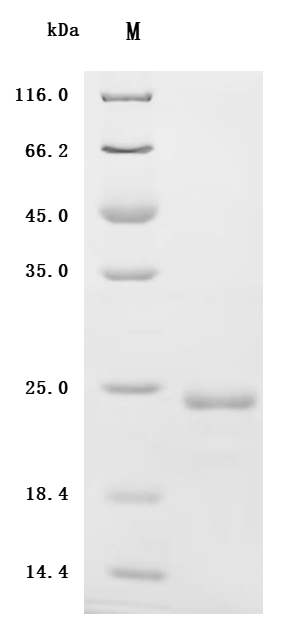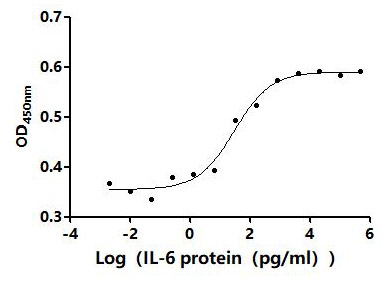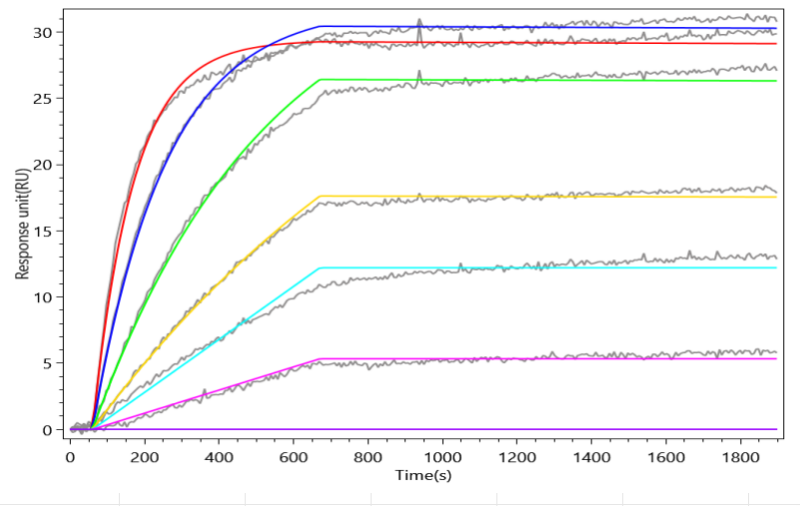The steps for producing the recombinant human IL6 protein include cloning the target gene, constructing the plasmid, expressing the protein, purifying it, and analyzing its properties. The 30-212aa sequence of IL6 is amplified using specific primers and cloned into a plasmid that includes an N-terminal 6xHis-tag. The recombinant plasmid is transfected yeast cells, and 24 hours post-transfection, selective antibiotics are used to isolate successfully transfected cells. The cells are cultured and then lysed to release IL6, which is then purified using Ni-NTA affinity chromatography. The purity of the recombinant IL6 exceeds 95%, and the LAL tests show its endotoxin levels are below 1.0 EU/μg. Functional ELISA demonstrates its binding to the IL6 recombinant antibody (CSB-RA011664MA1HU) with an EC50 of 35.80-41.82 ng/mL.
Human IL6 is a multifunctional cytokine particularly important in inflammation and immune responses. It is primarily produced by immune cells such as macrophages, T cells, and B cells, as well as non-immune cells like fibroblasts and endothelial cells [1][6]. IL6 is involved in the acute-phase response, which is a crucial aspect of the body's defense mechanism against infections and injuries [4][5]. During such responses, IL6 levels can rise significantly, indicating its role as a pro-inflammatory cytokine [3][4].
When IL6 binds to IL6R, it forms a complex that activates the glycoprotein 130 (gp130), leading to the activation of various intracellular signaling pathways, including the JAK/STAT pathway that regulates immune responses, hematopoiesis, and inflammation [1][6][9]. Elevated levels of IL6 have been associated with several chronic inflammatory conditions, including rheumatoid arthritis, cardiovascular diseases, and various cancers [1][3][6]. Studies have shown that high IL6 levels correlate with poor prognosis in cancer patients, as it can promote tumor growth and metastasis [2][8][11]. Additionally, IL6 has been implicated in the pathogenesis of atherosclerosis, where it contributes to chronic inflammation within blood vessels [3][10].
Moreover, IL6 is recognized for its role as a myokine, a cytokine produced by muscle cells during exercise, which can influence metabolic processes and inflammation [7]. This dual role of IL6—acting as both a pro-inflammatory mediator and a regulator of metabolic functions—highlights its importance in health and disease [1][6][7].
References:
[1] Abeywardena, M., Leifert, W., Warnes, K., Varghese, J., & Head, R. (2009). Cardiovascular biology of interleukin-6. Current Pharmaceutical Design, 15(15), 1809-1821. https://doi.org/10.2174/138161209788186290
[2] Bello, A., Obadipe, J., Adewusi, O., & Ayanshina, A. (2021). Interleukin-6 differential expression in cancer patients of different clinical stages; a possible biomarker of cancer progression.. https://doi.org/10.21203/rs.3.rs-1103505/v1
[3] Fisman, E. and Tenenbaum, A. (2010). The ubiquitous interleukin-6: a time for reappraisal. Cardiovascular Diabetology, 9(1), 62. https://doi.org/10.1186/1475-2840-9-62
[4] Graham, E., Bastarache, E., Milad, E., Turiano, N., Cotter, K., & Mroczek, D. (2018). Physical activity mediates the association between personality and biomarkers of inflammation. Sage Open Medicine, 6. https://doi.org/10.1177/2050312118774990
[5] McCranor, B., Langdon, J., Prince, O., Femnou, L., Berger, A., Cheadle, C., … & Roy, C. (2013). Investigation of the role of interleukin-6 and hepcidin antimicrobial peptide in the development of anemia with age. Haematologica, 98(10), 1633-1640. https://doi.org/10.3324/haematol.2013.087114
[6] Mihara, M., Hashizume, M., Yoshida, H., Suzuki, M., & Shiina, M. (2011). Il-6/il-6 receptor system and its role in physiological and pathological conditions. Clinical Science, 122(4), 143-159. https://doi.org/10.1042/cs20110340
[7] Obeagu, E., Obeagu, G., Cantero, M., Okafor, C., Bot, Y., Eze, G., … & Uwakwe, O. (2022). Evaluation of plasma levels of interleukin 6 and iron of volleyball players based on heights and weight of a nigerian university students. Asian Journal of Medicine and Health, 147-152. https://doi.org/10.9734/ajmah/2022/v20i1030515
[8] Pine, S., Mechanic, L., Enewold, L., Chaturvedi, A., Katki, H., Zheng, Y., … & Harris, C. (2011). Increased levels of circulating interleukin 6, interleukin 8, c-reactive protein, and risk of lung cancer. Jnci Journal of the National Cancer Institute, 103(14), 1112-1122. https://doi.org/10.1093/jnci/djr216
[9] Scheller, J., Ohnesorge, N., & Rose-John, S. (2006). Interleukin‐6 trans‐signalling in chronic inflammation and cancer. Scandinavian Journal of Immunology, 63(5), 321-329. https://doi.org/10.1111/j.1365-3083.2006.01750.x
[10] Schuett, H., Luchtefeld, M., Grothusen, C., Grote, K., & Schieffer, B. (2009). How much is too much? interleukin-6 and its signalling in atherosclerosis. Thrombosis and Haemostasis, 102(08), 215-222. https://doi.org/10.1160/th09-05-0297
[11] Yarmus, L., Darwiche, K., Walter, R., Huang, H., Li, Z., Zarić, B., … & Zarogoulidis, K. (2013). Interleukin-6 cytokine: a multifunctional glycoprotein for cancer. Immunome Research, 09(01). https://doi.org/10.4172/1745-7580.1000062









